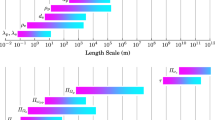Results are reported from the first detection of perturbations of space-time, gravitational waves of cosmic origin. An alternative approach to estimating the energy losses through gravitational waves in a binary system of astrophysical objects is introduced. Possibilities for further study are examined.

Similar content being viewed by others
Notes
A black hole is the simplest astrophysical object, which is characterized by mass, angular momentum (spin), and possibly charge. Instead of a physical boundary, these objects are described by a conditional event horizon at the Schwarzschild radius r S = 2GM/c 2.
References
B. P. Abbott, R. Abbott, T. D. Abbott, et al. (a total of 1280 authors, LlGO Scientific Collaboration and Virgo Collaboration), “Observation of gravitational waves from a binary black-hole merger,” Phys. Rev. Lett., 116 061102 (2016), DOI: http://dx.doi.org/10.1103/PhysRevLett.116.061102.
B. P. Abbott, R. Abbott, T. D. Abbott, et al. (a total of 1280 authors), “Astrophysical implications of the binary black hole merger gw150914,” Astrophys. J. Lett., 818, No. 2 (2016), DOI: http://dx.doi.org/10.3847/2041-8205/818/2/L22.
G. N. Izmailov, Gravitation. A Challenge for Experiment, LAMBERT Acad. Publ., Saarbrucken (2011).
G. N. Izmailov, “Transverse cross section of gravitational antennas, vacuum rigidity, and the weakness of gravitational waves,” Izmer. Tekhn., No. 5, 5–9 (2011).
A. Einstein and N. Rosen, “On gravitational waves,” J. Franklin Inst., 223, No. 1, 43–54 (1937), DOI: 10.1016/S0016-0032(37)90583-0.
H. Bondi, “Plane gravitational waves in general relativity,” Nature, 179, 1072–1073 (1957), DOI: 10.1038/1791072a0.
R. Feynman, “An expanded version of the remarks by R. P. Feynman on the reality of gravitational waves,” The Role of Gravitation in Physics: Proc. Conf., Chapel Hill NC, USA (1957), p. 143.
F. Pirani, “Invariant formulation of the theory of gravitational radiation,” in: Latest Problems in Gravitation, D. Ivanenko (ed.), IIL, Moscow (1961).
J. H. Taylor, L. A. Fowler, and P. M. McCulloch, “Measurements of general relativistic effects in the binary pulsar PSR 1913+16,” Nature, 277, 437–440 (1979), http://dx.doi.org/10.1038/277437a0.
M. Kramer, I. H. Stairs, R. N. Manchester, et al., “Tests of general relativity from timing the double pulsar,” Science, 314, No. 5796, 97–102 (2006), arXiv:astro-ph/0609417.
M. E. Gertsenshtein and V. I. Pustovoit, “Detection of low-frequency gravitational waves,” Zh. Eksp. Teor. Fiz., 43, No. 2(8), 605–607 (1962).
A. I. Golovashkin, G. N. Izmaïlov, G. V. Kuleshova, et al., “On a possibility of laboratory observation of the Lense-Thirring effect by SQUlD,” Proc. lnt. Conf. PIRT 2009, Bauman MSTU, Moscow (2009), pp. 146–154.
A. D. Dolgov and D. Ejlli, “Resonant high energy graviton to photon conversion at the post-recombination epoch,” Phys. Rev. D, 87, No. 10, 104007 (2013), Arxiv:1303.1556 [gr-qc].
N. I. Kolosnitsyn and V. N. Rudenko, “Gravitational Hertz experiment with electromagnetic radiation in a strong magnetic field,” Phys. Scr., 90, No. 7, 074059 (2015), http://iopscience.iop.org/1402-4896/90/7/074059.
A. I. Golovashkin, L. N. Zherikhina, A. M. Tskhovrebov, et al., “Ordinary SQUID interferometers and interferometers on the matter waves in superfluid helium: The role of quantum fluctuations,” Zh. Eksp. Teor. Fiz., 138, No. 2, 373–380 (2010).
P. W. Graham, J. M. Hogan, M. A. Kasevich, and S. Rajendran, “New method for gravitational wave detection with atomic sensors,” Phys. Rev. Lett., 110, 171102 (2013).
V. S. Gorelik, “Optics of globular photon crystals,” Kvant. Elektron., 37, No. 5, 409–432 (2007).
L. N. Zherikhina, G. N. Izmailov, and A. M. Tskhovrebov, “Quantum interferometer based on compressed states with paramagnetic modulation of kinetic inductance,” Izmer. Tekhn., No. 5, 10–15 (2016).
Author information
Authors and Affiliations
Corresponding author
Additional information
Translated from Izmeritel’naya Tekhnika, No. 6, pp. 6–9, June, 2016.
Rights and permissions
About this article
Cite this article
Izmailov, G.N. Emission of Gravitational Waves and Their Detection. Meas Tech 59, 560–564 (2016). https://doi.org/10.1007/s11018-016-1008-z
Received:
Published:
Issue Date:
DOI: https://doi.org/10.1007/s11018-016-1008-z




